20 Ring Worlds
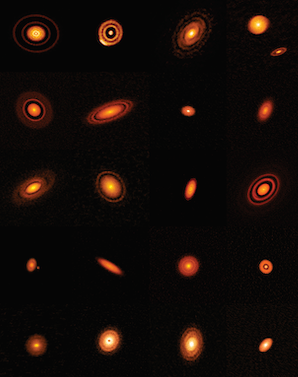 In a team of 17 scientists lead by Sean Andrews, we carried out the Disk Substructures at High Spatial Resolution Project, or DSHARP in short. This consists of over 60 hours of ALMA observations for 20 planet forming disks designed to study the occurrence, forms, locations, sizes, and other properties of structures in the disk material and how they might be related to the planet formation process.
In a team of 17 scientists lead by Sean Andrews, we carried out the Disk Substructures at High Spatial Resolution Project, or DSHARP in short. This consists of over 60 hours of ALMA observations for 20 planet forming disks designed to study the occurrence, forms, locations, sizes, and other properties of structures in the disk material and how they might be related to the planet formation process.We found that rings are everywhere, while spirals and asymmetries are sometimes present but rare. The positions of the rings show no correlation with the stellar brightness, which basically rules out that condensation fronts are responsible for the rings. Together with the other recent ALMA result (see three baby planets detected) this seems to indicate the planets form abundantly and faster than expected. At the same time, these results also open new questions, for example: why do all rings seem to be equally transparent? When do these structures (or planets) form, are they already present in much younger disks? What to disks in other star forming regions, that are less massive look like? We still have so much to learn ... ćA; You can read more about this
- in the press release or the Data Release Website,
- at Forbes,
- at Science Magazine,
-
or on LMU.de, Süddeutsche, or Neue Zürcher Zeitung for German coverage.
Three baby planets detected
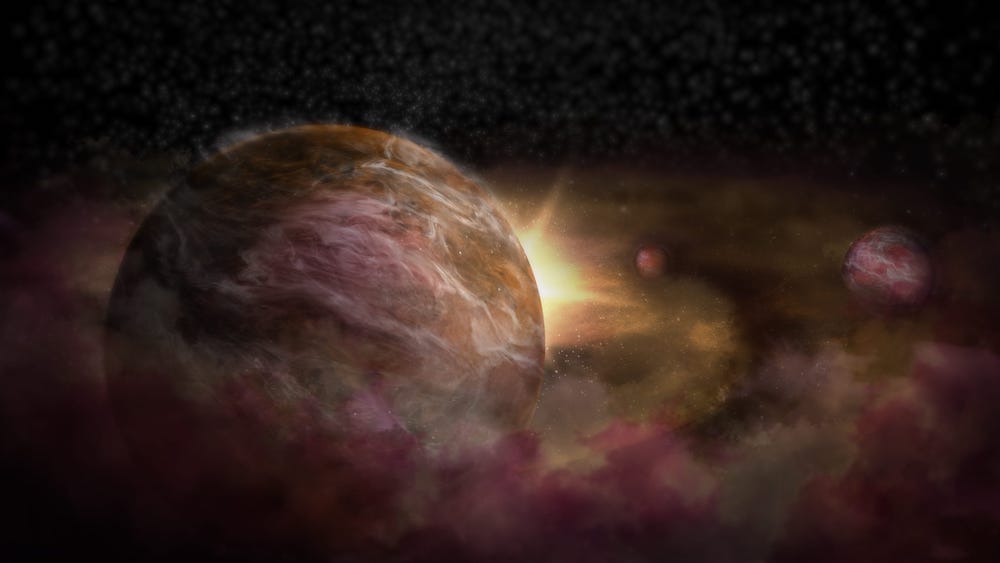 In Rich Teagues paper on HD163296 we used the ALMA observatory to hunt for baby planets in their natal environment, the planet forming disks. We use the Doppler effect to measure the gas rotation velocity with unprecedented precision of only a few meters per second. Keep in mind that the disk is about 300 light years away and rotates at speeds of a few kilometers per second!
Planets forming inside those disks perturb the gas and cause it to rotate slightly faster or slower. The detected rotation curves are a perfect match to predictions from planet-disk interaction, as coauthor Jaehan Bae carries out.
This is good evidence that indeed planets of about Jupiter mass have already formed in this particular disk around the young star HD163296. This is quite surprising, as astronomers have no idea how these massive planets formed so far away from their star (they are more than 80 times farther away from their star than the earth is from the sun). Next, we will apply this method to other disks to see if all the dust rings we see are caused by planets.
You can read more about this
In Rich Teagues paper on HD163296 we used the ALMA observatory to hunt for baby planets in their natal environment, the planet forming disks. We use the Doppler effect to measure the gas rotation velocity with unprecedented precision of only a few meters per second. Keep in mind that the disk is about 300 light years away and rotates at speeds of a few kilometers per second!
Planets forming inside those disks perturb the gas and cause it to rotate slightly faster or slower. The detected rotation curves are a perfect match to predictions from planet-disk interaction, as coauthor Jaehan Bae carries out.
This is good evidence that indeed planets of about Jupiter mass have already formed in this particular disk around the young star HD163296. This is quite surprising, as astronomers have no idea how these massive planets formed so far away from their star (they are more than 80 times farther away from their star than the earth is from the sun). Next, we will apply this method to other disks to see if all the dust rings we see are caused by planets.
You can read more about this
- on CNN,
- Popular Mechanics,
- Forbes,
- in an ESO Cast
-
or on LMU.de and Wissenschaft.de for German coverage.
New position - jobs available
ERC Starting Grant
18/10/16 09:32 filed under: work
Press Releases on TW Hya and HL Tau
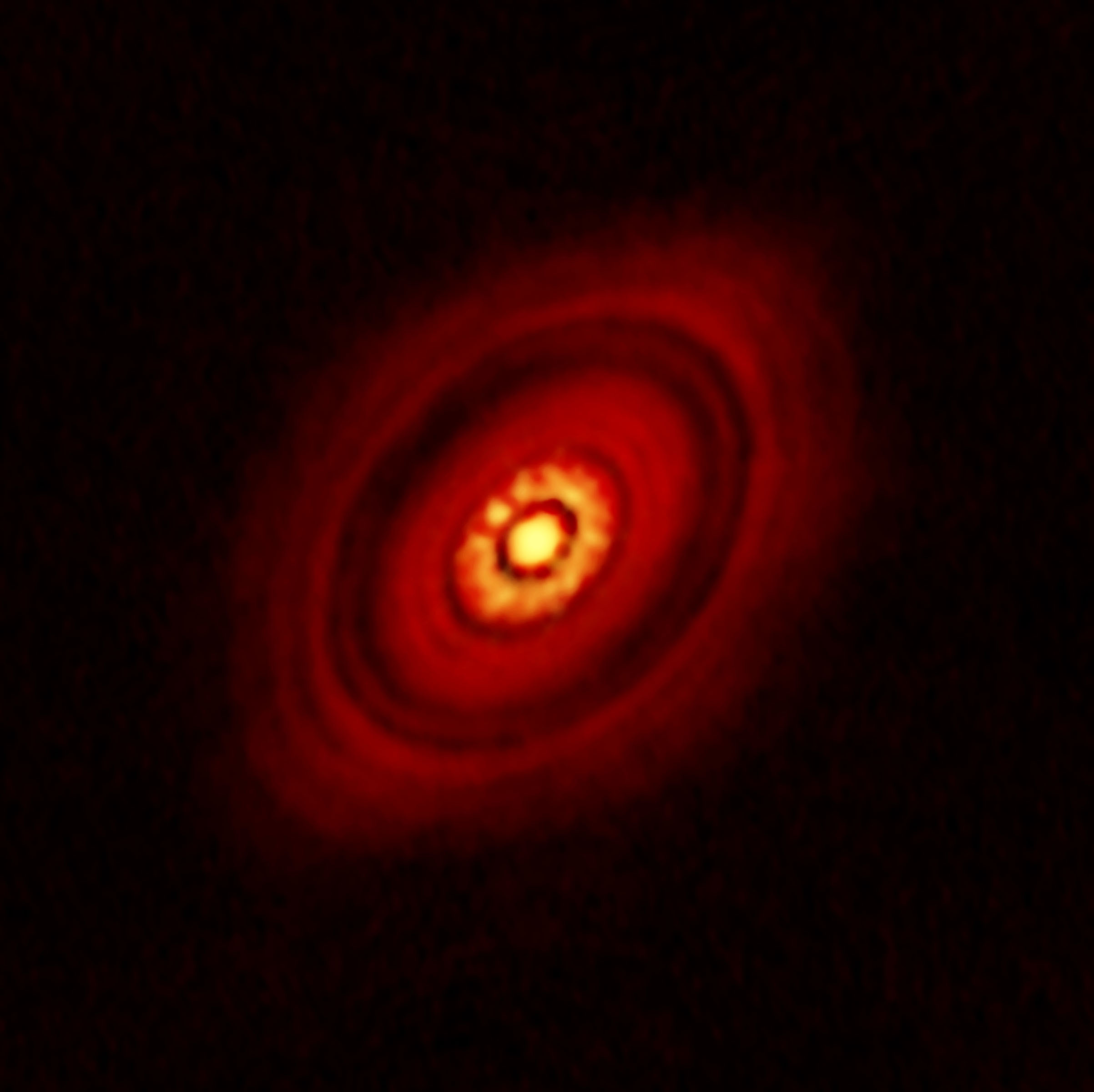 The last two weeks were busy - we released two press releases, both happened to be about observed substructure in disks.
The last two weeks were busy - we released two press releases, both happened to be about observed substructure in disks.The first one is on the iconic HL Tauri disk that we observed with the EVLA at optically thin wavelengths where we resolved a possible clump in the innermost ring.
For more information, you can read The second press release is about our ALMA observations of the TW Hya disk. These are pretty much the highest resolution observations ALMA can do aimed at the closest disk to us. Observations in the foreseeable future will not get much better than this. We found surprising ringed substructure, that is several ring/gap features, much narrower than seen in HL Tau. In addition to that, the inner gap that was predicted from analysis of the spectral intensity distribution before was finally imaged and found to be of 1 AU size. It is exciting to consider that these are likely the signposts of planets forming in the innermost regions of the system.
You can check out
- the ApJ letter on TW Hya
- the press release
- or read about it at Neue Zürcher Zeitung (GER)
- Astronews (GER)
- Forbes (ENG)
- Scientific American (ENG)
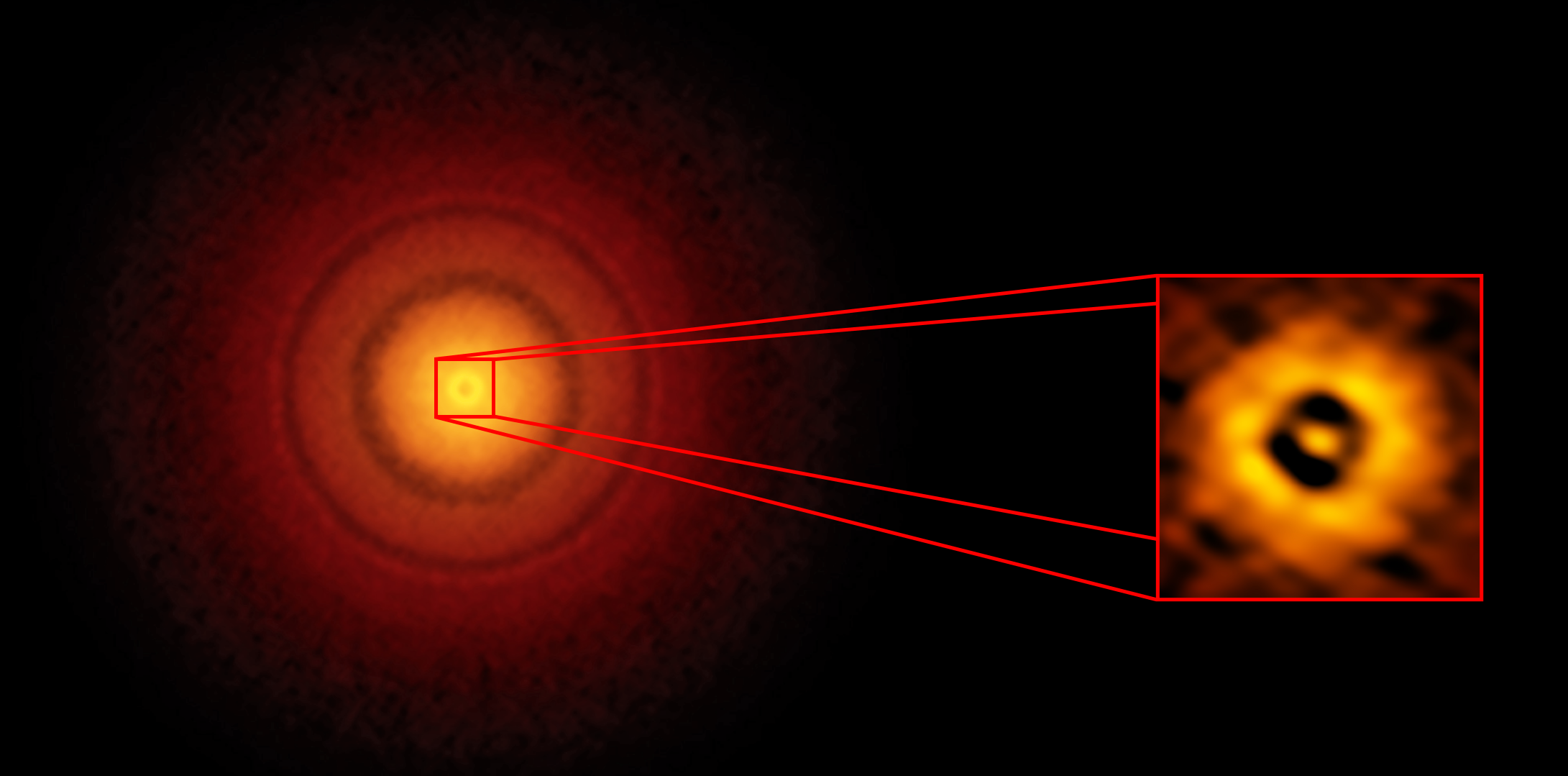
Colder than expected
It is commonly believed that dust in circumstellar disks, even far away from its central star, cannot be colder than about 15 degrees above absolute zero because there is always interstellar radiation that heats the dust particles to this minimum temperature. With this in mind, our measurements came as a surprise: we measured a dust temperature of only 7 degrees above absolute zero! There are some possible ways to explain this, but they all indicate that the dust grains have different shapes or different optical properties from what was commonly assumed.
Why does that matter? If we want to understand where planets can form and how large they can become, we need to know how much material is out there, in other words, we need to weight the disk. The methods to measure the masses of disks however rely on the knowledge of the dust temperature and other properties of the dust. Our measurements show that the dust seems to be quite different from what astronomers assumed it to be so far and they highlight why understanding the physics of those small dust particles is such an important part of understanding the origins of planets.
MPIA press release: English | German
ESO press release: English | German
Pre-transition Disks
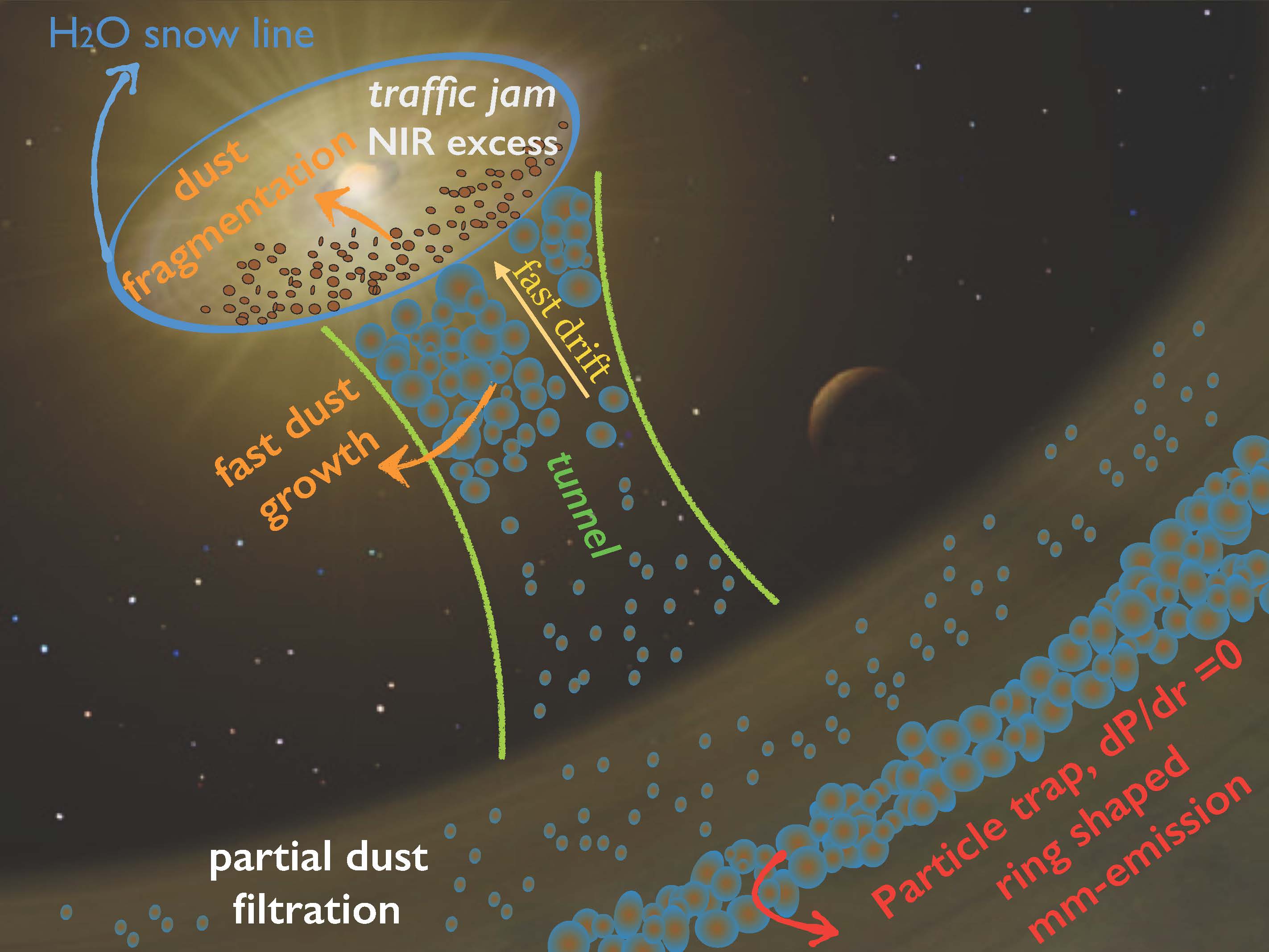 The origin of pre-transition disks, disks around young stars that consist of an outer and an inner dust ring, have puzzled researchers for decades. The inner rings seem to live very long, even though scientists did not think this could be possible. Our recent paper, published in Astronomy & Astrophysics, proposes a solution to this puzzle: the outer ring constantly supplies the inner ring, but it does so without being seen: the material is transported in only few large grains that are not easily detected. Therefore the regions between the rings do appear to be empty.
Once the dust particles have reached the hot inner regions close to the star, they loose the water ice that binds them together and consequently, they break up into many small pieces. It is these small pieces we see close to the star as a second, inner hot ring of dust.
Our paper was featured on
Astronomie.nl (Dutch).
The origin of pre-transition disks, disks around young stars that consist of an outer and an inner dust ring, have puzzled researchers for decades. The inner rings seem to live very long, even though scientists did not think this could be possible. Our recent paper, published in Astronomy & Astrophysics, proposes a solution to this puzzle: the outer ring constantly supplies the inner ring, but it does so without being seen: the material is transported in only few large grains that are not easily detected. Therefore the regions between the rings do appear to be empty.
Once the dust particles have reached the hot inner regions close to the star, they loose the water ice that binds them together and consequently, they break up into many small pieces. It is these small pieces we see close to the star as a second, inner hot ring of dust.
Our paper was featured on
Astronomie.nl (Dutch).
Press Release
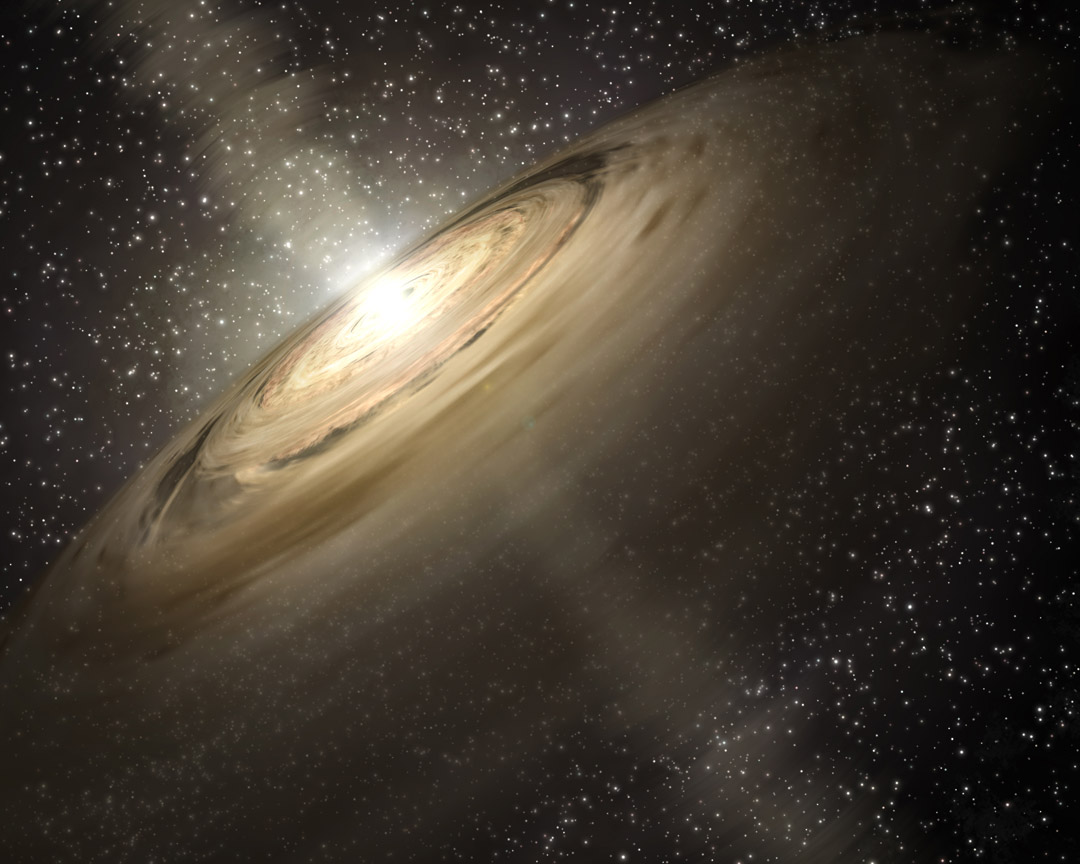 In our recent Astrophysical Journal Letter, we suggested that not all gaps that are seen in protoplanetary disks need too be caused by planets, but that some of them could be due to some sort of "cosmic illusion".
A press release for our letter was issued by the Harvard-Smithsonian Center for Astrophysics. It was also picked up by Astronomy Magazine, Discovery.com, Astronews.com (German), AstroBiology Magazine, and many others.
In our recent Astrophysical Journal Letter, we suggested that not all gaps that are seen in protoplanetary disks need too be caused by planets, but that some of them could be due to some sort of "cosmic illusion".
A press release for our letter was issued by the Harvard-Smithsonian Center for Astrophysics. It was also picked up by Astronomy Magazine, Discovery.com, Astronews.com (German), AstroBiology Magazine, and many others.
